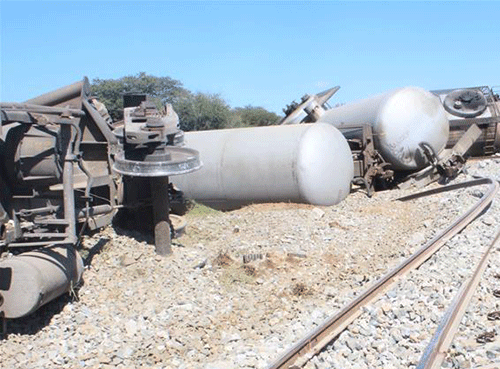Edgar Brandt
More than 50% of the railway lines that state-owned railway company TransNamib currently operate on do not meet the minimum Southern African Development Community (SADC) stipulated standard of 18.5 tonnes/axle load.
In fact, the conditions of some of the national railways’ critical sections are in such poor state that TransNamib is forced to dramatically reduce train speeds on these sections. The ageing infrastructure has led to 195 accidents during the last four years, causing the deaths of 12 people.
In an exclusive interview with New Era, TransNamib CEO Johny Smith explained that the necessary speed reduction on some sections of the railways is particularly evident on the company’s southern route, which is a critical revenue-enabler due to the movement of minerals between Ariamsvlei and Lüderitz.
He stated that TransNamib has over the past months closely engaged government, the owner of the national rail infrastructure and TransNamib’s sole shareholder, to lobby and advocate for essential investments in rail infrastructure.
TransNamib’s revenue generated from bulk commodities equates to about 93% of its revenue, while its properties portfolio brings in about 7% of revenue. This means that the mining and fuel sectors account for the majority of TransNamib’s bulk freight revenue.
“The company has been quite transparent in terms of the challenges we face in achieving our strategic goals, and these challenges directly correlate to the rail accidents. The poor condition of the rolling stock and our difficulties in leasing locomotives contribute to our rail safety challenges. We are operating locomotives that are well over 50 years old, when the lifespan of a locomotive is about 25 years,” stressed Smith.
TransNamib has managed to procure four leased locomotives which are expected to greatly boost its rail fleet, and is working on leasing an additional five locomotives within the next six months.
Meanwhile, Smith explained that the plan to refurbish 33 locomotives and procure 10 new locomotives as part of its business plan is dependent on the sourcing of funding, which is a process that is within the final phase.
The condition of the local railway infrastructure is also a challenge. “We have pushed as far as we can with the rolling stock that we have, but we need the procurement processes to move faster so that we can lease and purchase new locomotives. This will make a significant difference in our ability to operate in a safe and sustainable manner”, he reasoned.
Moreover, TransNamib currently spends only about 14% than it actually should on rail maintenance. The amount currently being spent on rail maintenance is N$25 750 per kilometre (FY 2020/21) versus N$185 000 per kilometre that should really be spent on railway infrastructure maintenance.
This, Smith observed, is due to TransNamib’s historical backlog and cash flow problems, which pose a formidable challenge in rail maintenance.
However, with the arrival of newly-leased locomotives, he anticipates that the increased capacity will boost revenue and enable more resources to be allocated to crucial rail maintenance.
Said Smith: “Government has also invested substantial resources in the rehabilitation of the line between Walvis Bay and Kranzberg. The line, which stretches close to 200 kilometres, is a critical line for TransNamib as it connects to the port of Walvis Bay. The upgraded railway line will enable TransNamib to increase its trains’ travelling times and move more cargo than it is currently doing. The rehabilitation project will cut down trains’ travelling time by 30%, and allow the company to increase its axel loads to 18.5 tonnes per axle”. He was appointed to lead the parastatal in February 2018.
Responding to what feedback he had received from government on a request for a capital injection of N$2 billion needed to turn around the ailing parastatal, Smith said: “We have been on a continuous basis engaging our shareholder on the status of our progress, our challenges, and the assistance need. The communication between TransNamib and the shareholder is an ongoing process”.
Furthermore, TransNamib signed an agreement with Botswana Railways to establish a container terminal at Gobabis. But, he admitted that TransNamib does not currently have the capacity in terms of locomotives to run a train service between Walvis Bay and Gobabis, which is delaying the development of a container terminal to support the Botswana market.
“We are working on increasing our rolling stock capacity to be able to start operating such a service, and eventually developing such a terminal effectively”.
When pressed on TransNamib’s current financial status, Smith said: “If you had asked me this question before Covid-19 hit Namibia, I would have told you that TransNamib was making significant improvements and well on its way to changing its financial status. However, the company was critically impacted by Covid-19. In the first month of our new financial year, which started with the restrictions imposed on movement, we lost about 50% of our revenue”.
Given that the transport sector was identified as one of the industries hardest-hit by the impact of Covid-19, TransNamib still faces a significant challenge with cash flow. However, Smith remained optimistic that TransNamib’s fortunes can be turned around with the arrival of the leased locomotives that are expected to start arriving from next month.
“The increased capacity will allow us to move more bulk freight, and we should be able to see an improvement in the company’s financial situation within the next six months”.
Public enterprises minister Leon Jooste recently appointed an accounting firm, EY, to investigate the affairs of the national railway company. Ministerial spokesperson Jonathan Swartz confirmed the appointment to the media, noting that the firm will be paid N$650 000 for the investigation, which is set to run from 1 August to 30 October 2021.
Photo: TransNamib
Caption: Collision course… A TransNamib train derailment near Otjiwarongo in 2018. During the last four years, the company has recorded 195 accidents which led to the deaths of 12 people. Photo: Xinhuanet.com


